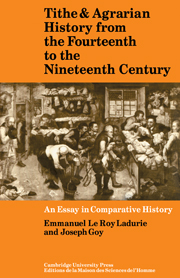 Tithe and Agrarian History from the Fourteenth to the Nineteenth Century
Tithe and Agrarian History from the Fourteenth to the Nineteenth Century Book contents
- Frontmatter
- Contents
- List of figures
- Preface
- Part I Methodology
- Part II Comparative study of trends
- 5 The end of the Middle Ages: the work of Guy Bois and Hugues Neveux
- 6 The recovery of the sixteenth century
- 7 The seventeenth century: general crisis or stabilization?
- 8 The eighteenth century: economic take-off?
- Notes
- References
- Title in the series
- Industrialization before Industrialization Rural Industry in the Genesis of Capitalism
7 - The seventeenth century: general crisis or stabilization?
Published online by Cambridge University Press: 05 November 2011
- Frontmatter
- Contents
- List of figures
- Preface
- Part I Methodology
- Part II Comparative study of trends
- 5 The end of the Middle Ages: the work of Guy Bois and Hugues Neveux
- 6 The recovery of the sixteenth century
- 7 The seventeenth century: general crisis or stabilization?
- 8 The eighteenth century: economic take-off?
- Notes
- References
- Title in the series
- Industrialization before Industrialization Rural Industry in the Genesis of Capitalism
Summary
On the whole, despite many fluctuations, the product of the tithe became more stable during the seventeenth century. We can, if we like, talk of a general crisis in the seventeenth century, but the situation, at least in France, was not the same as that produced by the dramatic collapses of the fourteenth and fifteenth centuries. In the seventeenth century cereal production did not necessarily fall permanently below the ceilings reached in the sixteenth century (or, shall we say, below the levels of recovery equal to those which had been reached before the Black Death of 1348). But it often fluctuated around levels distinctly lower than these ‘ceilings’, at least during a few particularly dangerous periods. In any case, cereal production, at least in France, did not often exceed the levels mentioned above. It would be more accurate to talk of a period of stagnation or stability (stabilization or ‘normalization’) rather than of ‘general crisis’ in the seventeenth century.
As far as the medium, as opposed to the long, term is concerned, one thing is clear: whatever the differences in timing between one European country and another, there was a general crisis in Europe around 1640–50 – the result of wars, taxes, the weather, occasional revolutions and possibly a shortage of precious metals for minting.
- Type
- Chapter
- Information
- Tithe and Agrarian History from the Fourteenth to the Nineteenth CenturyAn Essay in Comparative History, pp. 120 - 153Publisher: Cambridge University PressPrint publication year: 1982


